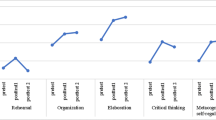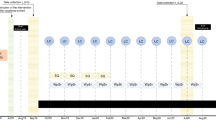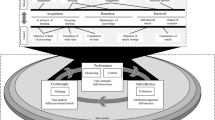Abstract
The research to explain student’s self-regulated learning has grown rapidly in recent years. However, the studies on self-regulated learning have shown fascinating but mixed results. Thus, there is a need to identify and describe the key dimensions of self-regulated learning according to an empirical framework in order to integrate these complex results. This study attempts to explore the structure and the pattern of self-regulated learning. In a sample of high-school students, it was found that self-regulated learning consists of three components; cognitive regulation, motivational regulation, behavioral regulation. The result also shows that students can be grouped into six clusters in terms of these components. This study appears to be useful for understanding self-regulated learning conceptually but has some methodological limitations.
Similar content being viewed by others
References
Ames, C. & Archer, J. (1988). Achievement goals on the classroom: Students’ learning strategies and motivational processes.Journal of Educational Psychology, 80, 260–267.
Ames, C. (1992). Classrooms: goals, structures, and student motivation.Journal of Educational Psychology, 84, 261–271.
Bandura, A (1989). Human Agency in social cognitive theory.American Psychologist,44, 1175–1184.
Bollen, K. A. (1989).Structural Equations with Latent Variables. NY: John Wiley & Sons.
Corno, L. & Mandinach, E.B. (1983). The role of cognitive engagement in classroom learning and motivation.Educational Psychologist, 18, 88–108.
Dweck, C. S., & Leggett, E.L. (1988). A social cognitive approach to motivation and personality.Psychological Review, 95, 256–273.
Elliot, E. S. & Dweck, C. S. (1988). Goals: An approach to motivation and achievement.Journal of Personality and Social Psychology, 54, 5–12.
Hair, Jr, J. F., Anderson, R. E., Tatham, R. L., & Black, W. C. (1995).Multivariate data analysis with readings(4th ed.). NJ: Prentice-Hall Inc.
Joreskog, K & Sorbom (1993).LISREL 8: Structural Equation Modeling and Prelis2. Chicago:SSI
Kuhl, J. (1985).Volitional mediators of cognition-behavior consistency: self-regulatory processes and action versus state orientation. In J. Kuhl & J. Beckmann (Eds.),Action cotrol: from cognition to behavior, West Berlin: Springer-Verlag.
Kuhl, J. (1987). Action control: the maintenance of motivational states. In F. Halisch., & J. Kuhl (Eds.),Motivation, intention, and volition, New York: Springer-Verlag
Loehlin, J. C. (1998).Latent variable models. NJ: Lawrence Erlbaum Associates.
Newman, R.S. & Goldin, L. (1990). Children’s reluctance to seek help with schoolwork.Journal of Educational Psychology, 82, 92–100.
Nicholls, J. G. (1984). Achievement motivation: conceptions of ability, subjective experience, task choice, and performance.Psychological Review, 91, 328–346.
Nolen, S. B. & Haladyna, T. M. (1990). Personal & Environmental influences on students’ beliefs about effective study strategies.Contemporary Educational Psychology, 15, 116–130.
Paris, S. G. & Brynes, J.P. (1989).The constructive approach to self-regulation and learning in the classroom. In D.Schunk & B. Zimmerman (Eds.).Self-regulation of learning and performance: issues and educational applications. Hillsdale, NJ: Lawrence Erlbaum Associates.
Peterson, P. L., Swing, S. R., Braverman, M. T., and Buss, R. (1982). Students’ aptitudes and their reports of cognitive processes during direct instruction.Journal of Educational Psychology, 74, 535–547.
Pintrich, P. R. (1991). Editor’s comment.Educational Psychologist, 26, 199–205.
Pintrich, P. R., & De Groot, E.V. (1990). Motivational and self-regulated learning components of classroom academic performance.Journal of Educational Psychology, 82, 33–40.
Pintrich, P. R., Smith, D. A. F., Garcia, T., & McKeachie, W. J. (1993). Reliability and predictive validity of the motivated strategies for learning questionnaire.Educational and Psychological Measurement, 53, 801–813.
Schunk, D. H. (1983). Developing children’s self-efficacy and skills: the roles of social comparative information and goal setting.Contemporary Educational Psychology, 8, 76–86.
Schunk, D. H. (1990). Goal setting and self-efficacy during self-regulated learning.Educational Psychologist, 25, 71–86.
Weinstein, C. E & Mayer, R. E. (1986). The teaching of learning strategies. In M.C. Wittrock (Eds.).Handbook of research on teaching. Macmillan.
Weinstein, C. E., Schulte, A., & Palmer, D. (1987). LASSI:Learning and study strategies inventory. Clearwater, FL: H & H Publishing.
Wigfield, A. (1994). The role of children’s achievement values in the self-regulation of their learning outcomes. In B. J. Zimmerman & D. H. Schunk(Ed.).Selfregulated learning and academic achievement: Theory, research, and practice, NY: Springer-Verlag.
Zimmerman, B. J. (1986). Becoming a self-regulated learner: Which are the key subprocesses?.Contemporary Educational Psychology, 11, 307–313.
Zimmerman, B. J. (1989). Models of self-regulated learning and academic achievement. In B. J. Zimmerman & D. H. Schunk (Eds.).Self-regulated learning and academic achievement: Theory, research, and practice, NY: Springer-Verlag.
Zimmerman, B. J. (1989b). A Social cognitive view of self-regulated academic learning.Journal of Educational Psychology, 81, 329–339.
Zimmerman, B. J. & Martinez-Pons, M. (1986). Development of a structured interview for assessing student use of self-regulated learning strategies.American Educational Research Journal, 23, 614–628.
Zimmerman, B. J. & Martinez-Pons, M. (1988). Construct validation of a strategy model of student self-regulated learning.Journal of Educational Psychology, 80, 284–290.
Zimmerman, B. J. & Martinez-Pons, M. (1990). Student Differences in self-regulated learning: relating grade, sex, and giftedness to self-efficacy and strategy use.Journal of Educational Psychology, 82, 51–59.
Zimmerman, B. J. & Schunk, D. H. (1989).Self-regulated learning and academic achievement: Theory, research, and practice. NY: Springer-Verlag.
Author information
Authors and Affiliations
Corresponding author
Rights and permissions
About this article
Cite this article
Yang, M. Investigating the structure and the pattern in self-regulated learning by high school students. Asia Pacific Educ. Rev. 6, 162–169 (2005). https://doi.org/10.1007/BF03026784
Received:
Revised:
Accepted:
Issue Date:
DOI: https://doi.org/10.1007/BF03026784




